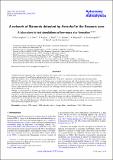Files in this item
A network of filaments detected by Herschel in the Serpens core : a laboratory to test simulations of low-mass star formation
Item metadata
| dc.contributor.author | Roccatagliata, V. | |
| dc.contributor.author | Dale, J. E. | |
| dc.contributor.author | Ratzka, T. | |
| dc.contributor.author | Testi, L. | |
| dc.contributor.author | Burkert, A. | |
| dc.contributor.author | Koepferl, Christine Maria | |
| dc.contributor.author | Sicilia-Aguilar, Aurora | |
| dc.contributor.author | Eiroa, C. | |
| dc.contributor.author | Gaczkowski, B. | |
| dc.date.accessioned | 2016-02-02T16:10:02Z | |
| dc.date.available | 2016-02-02T16:10:02Z | |
| dc.date.issued | 2015-12 | |
| dc.identifier | 240103882 | |
| dc.identifier | 07b7e01f-ada2-429c-bbe3-60742cbabdf6 | |
| dc.identifier | 84949559617 | |
| dc.identifier | 000384739600001 | |
| dc.identifier.citation | Roccatagliata , V , Dale , J E , Ratzka , T , Testi , L , Burkert , A , Koepferl , C M , Sicilia-Aguilar , A , Eiroa , C & Gaczkowski , B 2015 , ' A network of filaments detected by Herschel in the Serpens core : a laboratory to test simulations of low-mass star formation ' , Astronomy & Astrophysics , vol. 584 , A119 . https://doi.org/10.1051/0004-6361/201425253 | en |
| dc.identifier.issn | 0004-6361 | |
| dc.identifier.other | BibCode: 2015A&A...584A.119R | |
| dc.identifier.uri | https://hdl.handle.net/10023/8117 | |
| dc.description | V.R. was partly supported by the DLR grant number 50 OR 1109 and by the Bayerische Gleichstellungsförderung (BGF). This research was partly supported by the Priority Programme 1573 “Physics of the Interstellar Medium” of the German Science Foundation (DFG), the DFG cluster of excellence “Origin and Structure of the Universe” and by the Italian Ministero dell’Istruzione, Università e Ricerca through the grant Progetti Premiali 2012 -iALMA (CUP C52I13000140001). C.E. is partly supported by Spanish Grants AYA 2011-26202 and AYA 2014-55840-P. | en |
| dc.description.abstract | Context. Filaments represent a key structure during the early stages of the star formation process. Simulations show that filamentary structures commonly formed before and during the formation of cores. Aims. The Serpens core is an ideal laboratory for testing the state of the art of simulations of turbulent giant molecular clouds. Methods. We used Herschel observations of the Serpens core to compute temperatureand column density maps of the region. We selected the early stages of are cent simulation of star-formation, before stellar feedback was initiated, with similar total mass and physical size as the Serpens core. We also derived temperature and column density maps from the simulations. The observed distribution of column densities of the filaments was analyzed, first including and then masking the cores. The same analysis was performed on the simulations as well. Results. A radial network of filaments was detected in the Serpens core. The analyzed simulation shows a striking morphological resemblance to the observed structures. The column density distribution of simulated filaments without cores shows only a log-normal distribution, while the observed filaments show a power-law tail. The power-law tail becomes evident in the simulation if the focus is only the column density distribution of the cores. In contrast, the observed cores show a flat distribution. Conclusions. Even though the simulated and observed filaments are subjectively similar-looking, we find that they behave in very different ways. The simulated filaments are turbulence-dominated regions; the observed filaments are instead self-gravitating structures that will probably fragment into cores. | |
| dc.format.extent | 16 | |
| dc.format.extent | 5100971 | |
| dc.language.iso | eng | |
| dc.relation.ispartof | Astronomy & Astrophysics | en |
| dc.subject | Evolution | en |
| dc.subject | ISM: general | en |
| dc.subject | ISM: individual objects: Serpens Main | en |
| dc.subject | Submillimeter: ISM | en |
| dc.subject | ISM: structure | en |
| dc.subject | QB Astronomy | en |
| dc.subject | QC Physics | en |
| dc.subject | 3rd-DAS | en |
| dc.subject.lcc | QB | en |
| dc.subject.lcc | QC | en |
| dc.title | A network of filaments detected by Herschel in the Serpens core : a laboratory to test simulations of low-mass star formation | en |
| dc.type | Journal article | en |
| dc.contributor.sponsor | Science & Technology Facilities Council | en |
| dc.contributor.institution | University of St Andrews. School of Physics and Astronomy | en |
| dc.identifier.doi | https://doi.org/10.1051/0004-6361/201425253 | |
| dc.description.status | Peer reviewed | en |
| dc.identifier.url | http://adsabs.harvard.edu/abs/2015A%26A...584A.119R | en |
| dc.identifier.grantnumber | ST/M001296/1 | en |
This item appears in the following Collection(s)
Items in the St Andrews Research Repository are protected by copyright, with all rights reserved, unless otherwise indicated.

